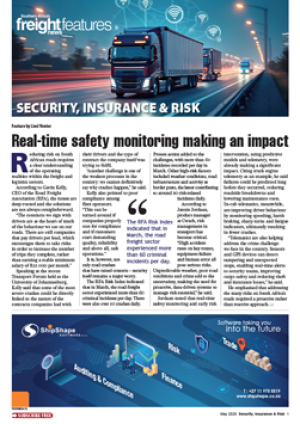Insurers drop premiums as IDC installs state-of-the-art system
SHOCK FIGURES have been revealed by the SA Police Services (SAPS) hijack unit as container transport major International Delivery Company (IDC) launches a high-tech satellite tracking system to combat the hijack menace.
At the launch function last week Colonel Marius Lubbe and his squad of hijack fighters told FTW that 15 heavy commercial vehicles a week are hi-jacked in Gauteng alone.
To add to the horror of the enormity of this problem - and what big carriers like IDC are facing - the average value of each hijack is R1-million to R1,5-million a hit (vehicle and cargo value).
That's a theft rate in Gauteng of anything up to R22,5-m a week - or well-over R1-billion a year.
Clifford Blackburn, newly-appointed m.d. of IDC said: You can see what we are faced with as road transporters. Losses which - for the uninsured or self-insured - are crippling effects on their bottom line. And, for those who insure, premium rates which get pushed-up with every incident.
On the insurance angle, Blackburn pointed to just one example of how insuring container-loaded rigs is almost impossible for those who cannot prove to have instituted effective anti-hijack precautions.
On the run from Durban to the Reef with a R2-m cargo, you are looking at a flat-rate for insurance of about 0,35% of total value insured, he said. That's a one-off premium of about R7 000. When you measure that against the going freight rate on that route of R1 500 per trip, you can see just how impossible full insurance is for every trip your vehicles make.
And with anything up to R80-m of vehicles, and up to R150-m of cargo on the roads every day, IDC is obviously a prime target for container-theft criminal syndicates.
Recognising that the SAPS were just too thinly spread around the country to effectively police all the major routes - and go head-to-head with the major road-robbery syndicates - a co-operative security exercise was conducted between IDC and the SAPS hijack experts.
The first phase was designed along the lines of military logistics, said Blackburn, with seven main elements directed at reducing risk in each of the main links of the logistics chain.
But, like most strategic plans, we identified gaps in this security procedure. Too many to promise us getting as close to 100% success in combating hijacking as we would have liked.
But the latest addition to the fleet protection strategy - the C-Track satellite tracking system - brings IDC as close to perfection as possible.
Whereas before, a lot of the route was not monitored - apart from specified call-in points - we are now in touch with every move that the vehicle or driver make every second of their scheduled run, said Blackburn.
This system gives a continual, on-screen read-out of all the driver's driving habits, and what he is doing every instant of his trip.
The system also monitors all the vehicle's operational data.
And - despite it being an unwanted necessity - Blackburn is convinced that the system is an investment which will gain an adequate return in the longer term.
It's in the area of insurance that the ultimate pay-back will be gained, Blackburn added.
Before, we could only know about a hijacking after the event, he said.
But now, we know instantly it happens - with every chance of catching the crooks red-handed at the scene.
Because of its effectiveness, it has the insurance industry's stamp of approval, and it brings down the premiums enough to make insurance financially feasible, and - in the long-term - the installation of this system will actually prove a saving for us.
